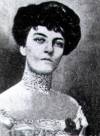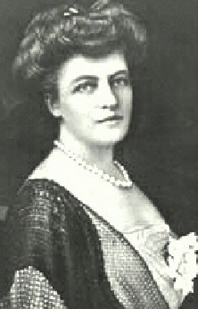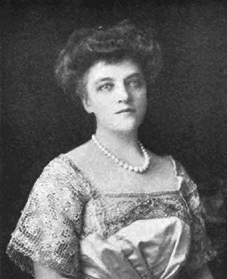Mrs. Eleanor Widener
First class passenger

“I went on deck and was put in a lifeboat. As the boat pulled away from the Titanic I saw one of the officers shoot himself in the head."
Mrs. Widener was aged 50 at the time of the disaster, her full official name Mrs. George Dunton Widener (neé Eleanor Wilkins) and she was traveling with her husband George, also 50, (who presided over one of the greatest fortunes in America) and their son Harry, 27. Both George and Harry did not survive. The family residence is listed as Elkins Park, Philadelphia, PA and they embarked Titanic at Cherbourg, France. Known as 'Nellie' to her friends, she was remembered by her nephew Arrell as slightly plump but with a face “full of good humour and energy” and possessing a “brittle wit” (Last Dinner on the Titanic, p.137 (30.)). James Cameron’s Titanic Explorer CD-ROM reports that the family was “cream of Philadelphia society… Eleanor … was a prominent philanthropist.” (41.) On the night of the disaster, she and her husband organised a dinner party with Captain Smith as their guest. After the tragedy she “devoted much of the rest of her life to extensive charitable works, the most notable of which was the Harry Elkins Widener Memorial Library which she built for Harvard University…She passed away in Paris in 1937.” (Illustrated History, p.223 (2.))

Mrs. Eleanor Widener, 1909.(8.)
During the evacuation, she boarded lifeboat No.4, loaded by Second Officer Lightoller. No.4 also contained many other prominent passengers, including Mrs. Astor, Mrs. Thayer, Mrs. Ryerson and Mrs. Carter. It is generally believed that it was launched from the port side at 1:50 –1:55am. Richard Edkins of the Dalbeattie web-site contests that it was launched at 1:00am, asserting the reason as being the number of prominent passengers aboard. He writes: “Unfortunately, though much-quoted, No. 4 would have been too far off for accurate identification of crew on the deck. Cameron’s set [for the film “Titanic”] was probably far more brightly lit than the genuine Titanic.” (Richard Edkins, Murdoch of the Titanic (1.))
However, Mr. Edkins is likely confusing the lowering time and the loading time of No.4. According to Triumph and Tragedy, “when second officer Lightoller lowers port boat number 4 from the boat deck to the promenade deck at 12:45, he intends to load passengers through the windows in the promenade deck’s forward screen. The windows, however, are closed…Lightoller finishes loading the other boats and returns to number 4…the women are assisted into the boat after more than an hour’s wait.” (7.) In other words, although the boat was lowered to the promenade, or A deck, at 12:45am, the prominent passengers had to wait “more than an hour” before actually being loaded into the boat. This naturally brings the time to 1:50am. The fact that the sinking is well progressed is also emphasised in occupant Mrs. Emily Ryerson’s account in which she describes that they “reached the water only a few feet below. The C-deck portholes were quickly disappearing beneath the surface…. As boat No.4 pulled away… the larger, rectangular B-deck windows were soon awash…” (Illustrated History, p.130 (2.))
We even have evidence from Second Officer Lightoller himself, who admitted that though No.4 was the first boat he prepared for lowering, due to an oversight, it was one of the last boats he actually launched: “I might say that previous to putting this Berthon [collapsible] boat out we had lowered a boat from A deck one deck down below. That was through my fault. It was the first boat I had lowered. I was intending to put the passages in from A deck. On lowering it down I found the windows were closed.” (United States Inquiry, Day One). Also, detailed evidence from greaser Thomas Ranger and Mrs Ryerson in regard to the forward funnels collapsing and Titanic splitting in two give credence to their proximity during Titanic’s final moments. In fact, greaser Ranger stated that they were 50 to 100 yards (46 – 91 metres) away when the ship broke in two, before which they would have been much closer (Walter Lord, The Night Lives On (21.)).

Mrs. Eleanor Widener, 1909.
(Click image to enlarge)
Consequently, lifeboat No.4 pulled away from Titanic closer to 2am -not 1am- and was not “too far off for accurate identification of crew on the deck”. It would have been at the right distance. The problem lies in the fact that it was launched from the port side, while Murdoch was working the starboard side. This could possibly be resolved in that No.4 received orders to pick up more passengers at a “companionway aft...[Quartermaster] Perkis [in charge of the boat] ordered the men to pull for the stern” (Illustrated History, p.130 (2.)). In all likelihood, No.4 may have completed a circuit of the ship looking for what was to be an elusive companionway, possibly ending up on the starboard side or at some other vantage point to view the activities aboard the sinking ship.
Mrs. Widener’s evidence is, according to Mr. Edkins, contained in a letter, the rest of the contents of which the author has not had access to: “I went on deck and was put in a lifeboat. As the boat pulled away from the Titanic I saw one of the officers shoot himself in the head.” (1.) Bill Wormstedt also found it in The New York Times of April 20, 1912, with some additional information: “As the boat pulled away from the Titanic I saw one of the officers shoot himself in the head, and a few minutes later saw Capt. Smith jump from the bridge into the sea.” (12.) Interestingly, this additional information ties in with several other accounts regarding Captain Smith, notably from junior wireless operator Harold Bride, who also mentioned the Captain jumping from the bridge into the sea.
Conclusion
Is there any reason to doubt the words of a woman of much respect in society – a philanthropist? There is certainly no evidence of any grudge against Titanic’s crew, having had the foremost member, Captain Smith, as a guest of their dinner party only hours before.
Verdict: